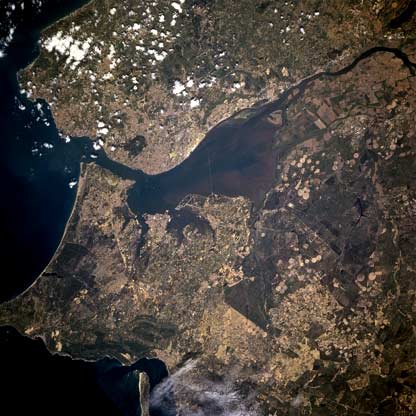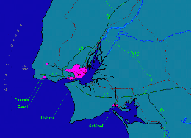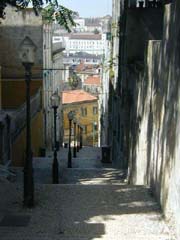 |
 |
 |
|
 |
2007 CupInfo: Potential Locations for the Defense
ÔĽŅ
Lisbon/Cascais, Portugal
|
Marseille, France
|
Naples,
Italy
Palma de Mallorca, Spain
|
Valencia,
Spain
Update: The America's Cup Event Authority announced April 1, 2011, that Cascais would host the first America's Cup World Series event in August, 2011. Cascais was a finalist to host the 2007 America's Cup Defense, and for a long time perceived as the favorite. This is a profile of Cascais/Lisbon as a potential 2007 America's Cup host. |
||||
|
Lisbon/Cascais,
Portugal Lisbon is by many accounts the front runner to host the 2007 defense of the America's Cup. Lisbon is fortunate enough to list many virtues in its support for the hosting role, including adequate shore space to build an America's Cup marina, easy access to ground and air transportation, cost advantages, and a solid wind regime. Most descriptions suggest that the America's Cup village would be located upriver from the center of Lisbon, along the Tagus Estuary. Racing would take place near shore to the west, off of the city of Cascais. Lisbon is an active modern port city, handling over 13 million
tons of cargo annually. The resort destination of Cascais
has a large marina. Alternate plans could see team bases
built in Cascais itself, but infrastructure concerns favor
Lisbon. |
CupInfo Extra:
|
|||
|
Strengths: |
||
| Sailing Conditions: | Strong consistent wind from Portuguese trade winds, 12-18 knots over 300 days per year. Tides are semidiurnal with two high tides and two low tides. The tidal range is about 3m. | |
| Race Course: | Expected to be off Cascais | |
| Team Infrastructure: | Ample available land fronting the Tagus Estuary upriver from Lisbon center, for bases, Cup village | |
| Support Infrastructure: | Major city with schools, lodging, services for teams and families | |
| Transportation: | Major international airport, rail service | |
|
Costs: |
Greater purchasing power relative to other venues | |
 |
 |
|
photos: © Emilie McCartney Waddell |
|
| General Information: | ||
| Population: | 680,000 (Lisbon) 10.3 Million (Portugal) | |
| Official Language | Portuguese | |
| Currency: Euro | Cost comparison: mineral water (1 l): Escudo 160/ Ä0.80 beer( 1 bottle): Esc100/ Ä0.50 Three-course meal with wine/beer: Esc1400-3200/ Ä7-16 |
|
|
Business Competitive Index: |
Portugal Rank: 36th (about the BCI) | |
|
Productivity: |
GDP per capita, Portugal Rank: 26th |
|
Travel: |
||
| Main Airport: | Aeroporto de Lisboa (Lisbon Airport), code: LIS
Direct Flights from major European cities, New York, Boston, Toronto: current arrivals |
|
| Rail Service: | rom Paris and Madrid (10 hrs.) | |
| Cascais | 25km from central Lisbon, 35 km from Aeroporto de Lisboa | |
|
Time Zone: |
GMT (GMT + 1 between Apr-Oct) | |
|
Electricity: |
220v 50 hz | |
|
Brief History: |
||||
Befitting its fabled setting among seven hills, legend has it that Lisbon was founded by Ulysses. Some evidence credits the Phoenicians as Lisbon's first settlers. Successively conquered by the various empires that waxed and waned around the Mediterranean region, the city endured a difficult and sometimes violent history until quite recently. Lisbon became the capital city of Portugal in 1260. Portugal itself lost its independence to Spain in 1580, then fought to regain its freedom, succeeding in breaking away from Spanish rule under the Treaty of Portugal in 1668. A devastating earthquake struck the city in 1755, though leaders used the opportunity to modernize both the city and its government. The country joined the EU in 1986 and the EMU in 1999. Today Portugal and Lisbon boast some of the highest economic growth rates in the EU, and among the lowest unemployment numbers. |
||||
|
|
|
Official Lisbon America's Cup Venue Site (offline)
More information:
|
About the photograph from space above |
|
Lisbon, Portugal April 1998 STS090-748-093 |
|
The Tagus River estuary is one of the best natural ports on the European continent and can accommodate large ocean going ships. The estuary also has the largest dry dock in the world. The intersecting runways for one of Lisbonís several airports are visible on a peninsula that extends westerly into the south side of the Tagus River estuary. Two bridges can be seen connecting the eastern shore with the built-up area of Lisbon. With the exception of the alluvial soil deposited by the Tagus River and the irrigated acreage along the delta and floodplain of the river, Portugal is not a country that has an abundance of arable land. The angular-looking field patterns found on the Tagus River delta (near upper right corner) and the circular patterns (center pivot irrigation southeast of the river) show the location and distribution of some of the productive farmland. The greater Lisbon area, including both the city and its suburbs, accounts for most of Portugalís commerce and much of its industry.
Photo Credit: Earth Sciences and
Image Analysis, NASA-Johnson Space Center. 30 Jun. 2003.
|
|
*Business Competitive Index is a measure of strength and opportunity in the business environment. The BCI is compiled by the World Economic Forum as part of their Global Competitiveness Survey. A simple explanation would mention that it is related to a country's GDP per capita, but, as might be expected where economists are at work, the analysis is much more complicated than simply that one ratio. See their website for more information. |
Inquiries please contact: